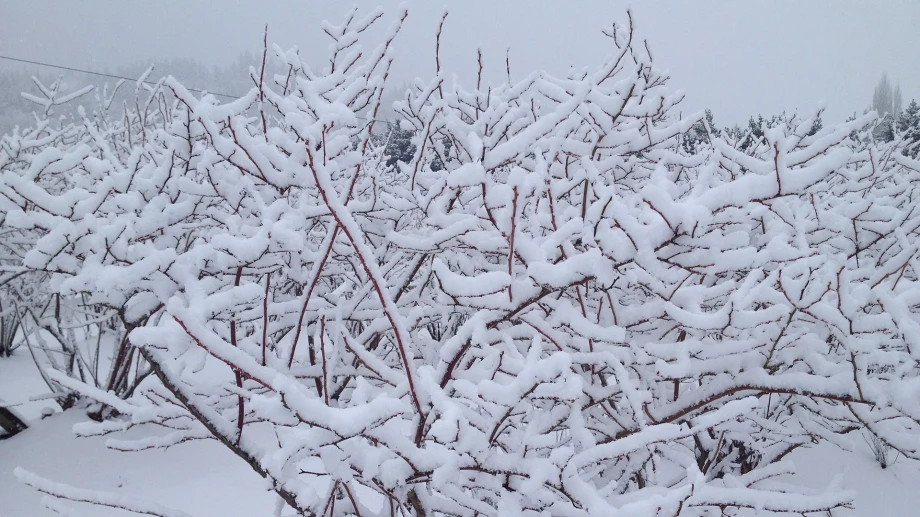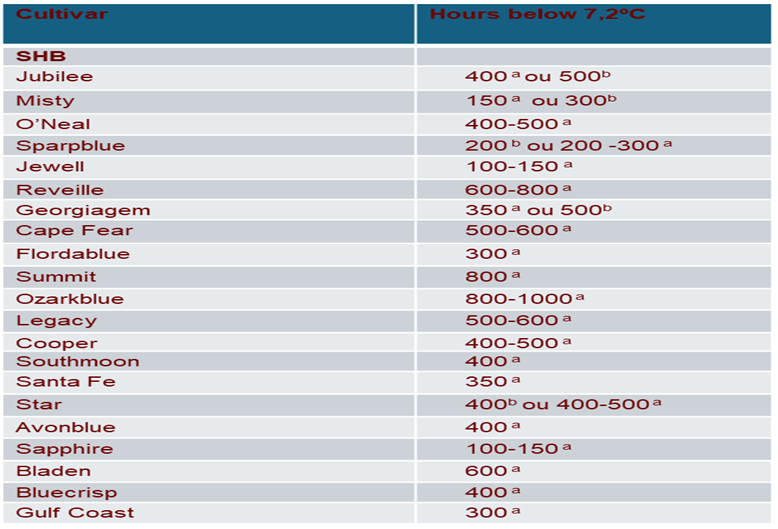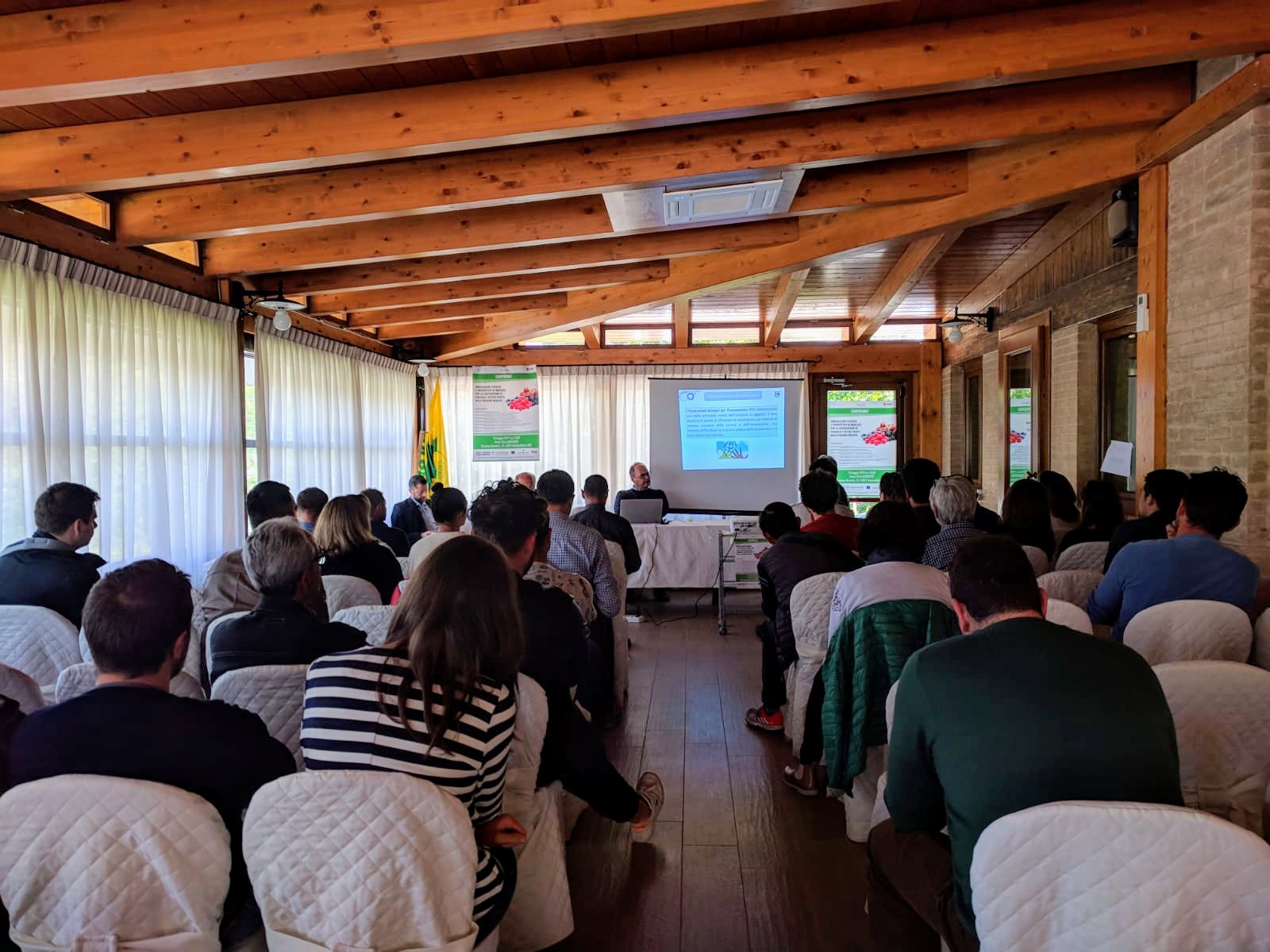Berries are a preferred fruit for a lot of us, however, to have them on what we call “the season”, plants need to overwinter, accumulate cold and get out of dormancy to get enough development and production for its variety and site of production. Nowadays we have been talking about climate change and its effect on crops.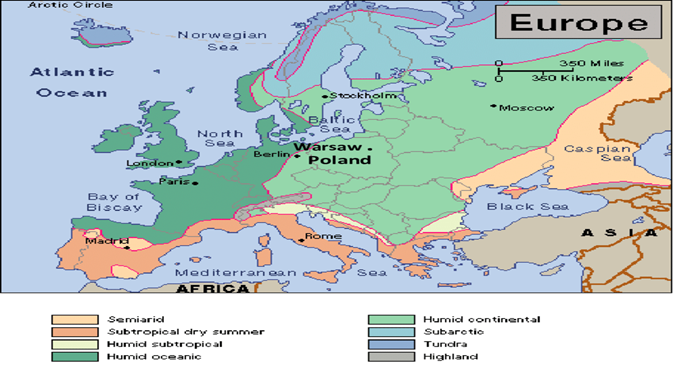 Climatic zones in Europe (source 1)
Climatic zones in Europe (source 1)
The global warming cause loss of vigor, fruit bearing ability, reduction fruits size, less juice content, poor ripening, reduced shelf-life and increasing attack of pests resulting in the low production and poor-quality fruits (Chhetri et al, 2018).
The loss of enough chilling hours to “wake up” just before the spring starts with a homogeneous flowering and luscious vigor is key to have a good start of the season. The cool winter temperatures are required by many fruit and nut trees that originate from temperate or cool subtropical regions to overcome winter dormancy.
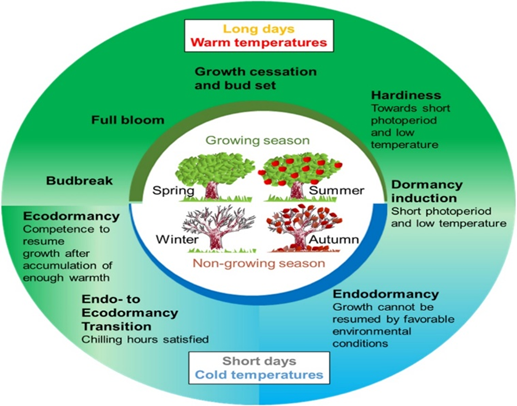 Source: Frontiersin (2)
Source: Frontiersin (2)
What is dormancy
Dormancy is a temporary cessation of growth of any part of a plant that has a meristem. A meristem is a group of cells that can divide to form new tissues and organs. Deciduous trees protect the dormant meristems in their shoots by enclosing them in buds. Different buds, on the same tree, at the same time, can experience different levels of dormancy.
The lack of growth of deciduous bushes, caneberris and fruit trees during winter is called endodormancy and is caused by growth-inhibiting factors within the bud itself — it is triggered and lifted by specific cues within the bud. A bud that is endodormant will not resume growth unless it has received the correct stimulus to lift the endodormancy.
Cold is often the cue for buds to become endodormant. Further cold is essential to lift that bud out of endodormancy. Transient warmer temperatures will not stimulate growth in a bud that is endodormant. This strategy protects plants — not starting growth during a brief warm spell prevents subsequent cold damage to their tender new flowers and leaves.
The process of winter dormancy
Cooler weather in autumn prompts canes, bushes, and trees to start preparing for the potentially life-threatening cold of winter. Shorter days also play a role in inducing dormancy. During this period plants stop growing and start storing nutrient reserves that will both sustain them during winter and power them up in spring. They form bud scales to protect their sensitive shoot meristems from low temperatures.
The relatively sudden onset of cold weather marks a clear start to winter dormancy on the plants in their native habitats. There, dormancy is considered in the start as soon as the trees lose their leaves.
Due our recent climate alteration, we have warmer autumns and winters aren’t sending clear a signal — the canes, bushes and trees take a long time to settle into their winter rest. Some varieties with lower chill requirement (evergreen characteristic) never even get as far as shedding all their leaves. This makes it hard to judge whether the plants are fully dormant or still only dozing off.
Deciduous canes, bushes and trees that are fully endo-dormant need a certain amount of cold — measured in chill units — before their buds become responsive to environmental triggers for growth.
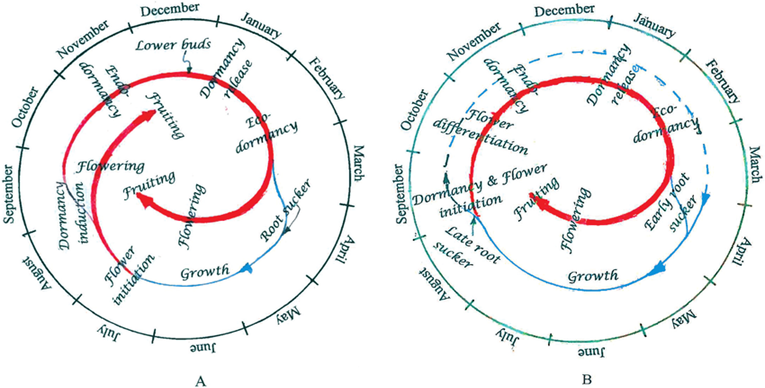
Lifecycle of primocane a) and floricane b) raspberries (Sonestby; Heide , 2011
Jennings et al (2015) propose a endodormancy model for floricane raspberriesJennings et al (2015) propongono un modello di endodormienza per i lamponi floricane.
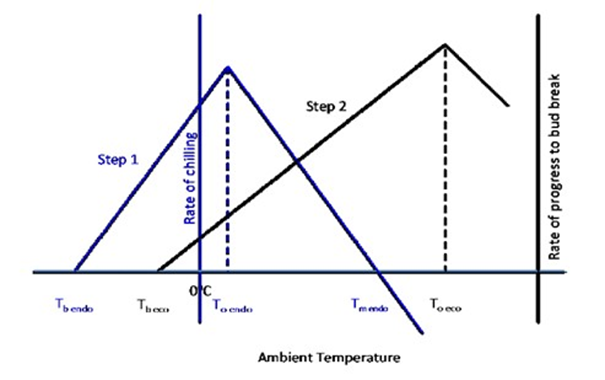
Source: Jennings et al (2015); A review of Dormancy and Chilling requirements in Raspberries
Different stages of fruit production for southern highbush blueberry under an evergreen production system (inner ring) and a deciduous production system (outer ring) in subtropical region.Diverse fasi della produzione di frutta per il mirtillo ad alto fusto del sud in un sistema di produzione sempreverde (cerchio interno) e un sistema di produzione deciduo (cerchio esterno) in regioni subtropicali.
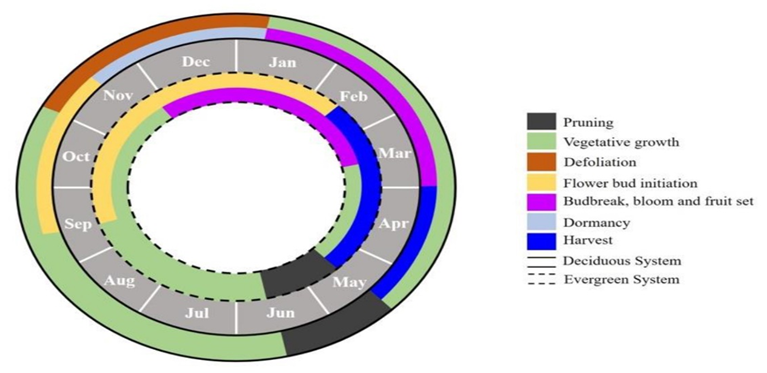
Source: Yang et al, (2020); A review for Southern Highbush Blueberry Alternative Production Systems
Chill accumulation
Chill requirement varies between species and cultivars. Chill accumulation starts when trees are fully endo-dormant. Low temperatures before this contribute nothing to fulfilling chill requirement. This is a problem when trying to measure how many chill units a tree has accumulated. In mild regions, you can never be sure when the tree is fully endo-dormant and stacking up those units.
Buds can resume growth as soon as temperatures become favorable after their chill requirement has been met. Bud-break and flowering are promoted by warmth. A hot spring is key to kick-starting trees that haven’t had enough winter rest. Trees that received sufficient chill will get moving even in a cool spring.
Luedeling et all (2009c), refers that sufficient winter chill results in homogeneous and simultaneous flowering. When fruit and nut crops are grown outside in their traditional growing regions, estimating the amount of chill required and that which is available is important.
These researchers group claims the chilling models can be used to determine the chilling requirement of a cultivar and the chill available at a particular location; however, they are not completely accurate. This means that the chilling process in trees is not completely understood and it is difficult to produce a model that perfectly explains the accumulation of winter chill.
The quantitative measurements of winter chill are required to determine the suitability of a cultivar to a particular growing region, to determine the timing of management practices such as applying rest-breaking chemicals, and to predict yield potential. Understanding the effect of dormancy completion level on interannual variation can also be facilitated by the use of chilling models (Zhang J.; Taylor C. , 2011).
Chilling hours requirement in different varieties of blueberries
aFonseca, L. L. & Oliveira, P. B. 2007. A planta de mirtilo. Morfologia e fisiologia. Folhas de Divulgação AGRO 556; Nº 2. INRB. 29 p. (citando: Eck, P. 1988. Blueberry Science. Rutgers University Press. e Spiers, J. M. 1976. Chilling regimes affect bud break in Tifblue Rabbiteye blueberry. J. Amer. Soc. Hort. Sci. 103: 705-708.) bLyrene PM e Williamson JG (1997) Highbush blueberry varieties for Florida. Proceedings of the Florida State Horticultural Society, 110, pp 171–174.
Models to calculate chill units
1. Chilling hours model
Chandler in 1942, created The Chilling Hours Model to quantify winter chill. According to this model, temperatures between 0°C and 7.2°C are assumed to have a chilling effect, with each hour at temperatures between these thresholds contributing one chilling hour. Chilling hours are thus accumulated throughout the dormant season and then summed up (Chhetri et al, 2018).
2. Utah model
The Utah Model developed in Utah, USA. It contains a weight function assigning different chilling efficiencies to different temperature ranges, including negative contributions by high temperatures. This model of chill units (CU) defines a CU as the permanence of the buds for a period of 1 hour in a temperature range considered optimum (2.5-12.5°C) to accumulate chill.
The Utah model is more complex because it introduces the concept of relative chilling effectiveness and negative chilling accumulation (or chilling negation).
According to Richardson et al. (1974) temperatures between 0 and 16 C promote the breaking of rest, whereas temperatures > 16 C negate such effects. Maximum promotion occurs at 7 ˚C (1 h at 7 ˚C = 1 chill unit); higher and lower temperatures within the 0-16 ˚C range are less effective.
The model is defined as: Richardson Model (a.k.a. Utah model) (source: https://products.climate.ncsu.edu/ag/chill-models/)
Chilling Inception:
- The day in the fall after the maximum negative number of chill units (above 15.9 °C) was accumulated.
Accumulation Per Hour
- <34.5°F (<1.4°C) = 0 unit
- 34.7°F to 36.3°F (1.5°C to 2.4°C) = 0.5 unit
- 36.5°F to 48.4°F (2.5°C to 9.1°C) = 1 unit
- 48.5°F to 54.3°F (9.2°C to 12.4°C) = 0.5 unit
- 54.3°F to 60.6°F (12.5°C to 15.9°C) = 0 unit
- 60.8°F to 64.4°F (16°C to 18°C) = –0.5 unit
- >64.4°F (>18°C) = –1 unit
The model presumes that chill accumulation occurs within a temperature range of 2.5 and 12.5°C, outside of which, the accumulation is nil or negative.
Dennis (2003) claim that this model, although it gives good results in cool and cold temperate climates, yields a large quantity of negative chill values in sub-tropical climates and because of this its utilization and applicability have been limited ((Chhetri et al, 2018).
A modification of this model consists of not considering the negative values of the Utah model, because of which it has been termed the model of Positive Chill Units (PCU) and its application in these sub-tropical zones has improved the results obtained (Chhetri et al, 2018).
3. Dynamic model
The Dynamic Model was developed in Israel (Fishman, 1987). It calculates chill units known as ‘chill portions’, based on hourly temperatures. According to the Dynamic model, effective winter chill temperatures follow a bell shape with an optimum chilling temperature at 6 °C, tapering to zero at –2 °C and 14 °C. High temperatures act to negate previously accumulated chill and moderate temperatures can enhance chill accumulation.
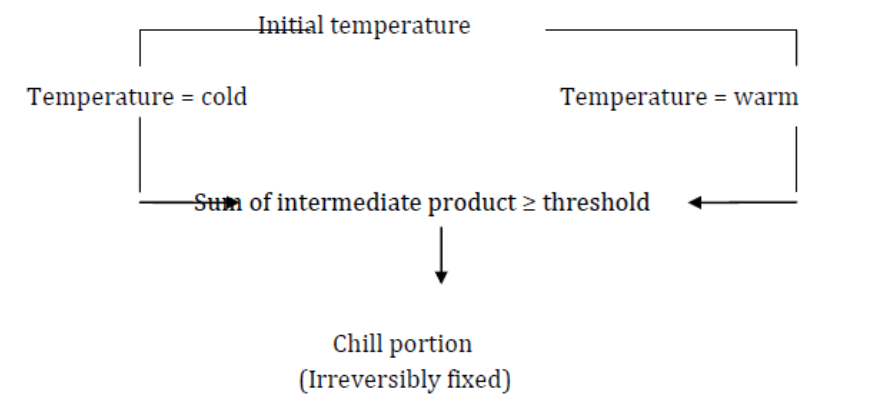
Summing chill portions over autumn and winter provides an estimate of accumulated winter chill. This complex model adds a further element of timing of exposure to temperatures in a cycle and appears to be far more accurate under warm winter conditions.
Several models of winter chill have been developed using the observed effects of temperature on dormancy breaking.
The Chill Hours model was the first to be developed and estimates winter chill based on hourly temperatures. This is a ‘yes–no’ model with temperatures between 0–7.2 °C allocated 1 chill hour (yes) and temperatures outside of that interval allocated a 0 chill hour (no).
These chill hours are summed over autumn and winter to give an estimate of total winter chill.
Knowledge of temperature effects on winter chill has since expanded and the Dynamic chill model is the current best practice model. It calculates chill in units known as ‘chill portions’, based on hourly temperatures. The Dynamic model has many features which capture known temperature-winter chill relationships which are lacking in other models including the Chill Hours model.
Conclusions
- Chill trend estimations depend strongly on the choice of chill model.
- Utah-like models estimated negative chill levels in Mediterranean climate sites.
- Dynamic and Positive Utah models consistently projected the smallest changes.
- Chilling Hours model among the most sensitive models in all sites.
- Chill increases in temperate areas – major reductions in Mediterranean sites.
- In major reductions in chill in Mediterranean sites will be necessary the use of dormancy breaking agents in caneberries, which is already a reality, and the cold store long cane system is already a reality for many years.
- For blueberries the adaptability of mid chill SHB hybrids (less requirement of chill) in nowadays high chill sites that will be having less chill accumulated can become more a reality as well the use of dormancy breaking agents in NHB for achieve a better budbreak and having a decent crop.
This content was produced with the technical contribution of Jorge Duarte (Hortitool Consulting)
Bibliography
- www.researchgate.net/figure/Climate-zones-in-Europe-Source-sitesgooglecom-27_fig4_34443310, 13 March; 2024
- https://www.frontiersin.org/files/Articles/409823/fpls-09-01990-HTML/ 13 March; 2024
- Chhetri A., Ramjan Md., Dolley N., 2018, Various models to calculate chill units in fruit crops College of Horticulture and Forestry, Central Agricultural University, Pasighat, Arunachal Pradesh, 13 March; 2024,
- Zhang j., Taylor C., 2011, The Dynamic Model Provides the Best Description of the Chill Process on ‘Sirora’ Pistachio Trees in Australia, HORTSCIENCE 46(3): pp420–425. https://agupubs.onlinelibrary.wiley.com/doi/full/10.1029/2019EF001178,13 March, 2024
- https://www.freshquarterly.co.za/winter-dormancy-101/; 13 March, 2024
- https://horticulture.ahdb.org.uk/knowledge-library/modelling-the-dormancy-and-chilling-requirements-in-raspberry, 2011,,13 March; 2024,
- Fang, et al., 2020; A Review for Southern Highbush Blueberry Alternative Production Systems, Agronomy2020, 10(10),1531; https://doi.org/10.3390/agronomy10101531, 13 March 2024
- Fonseca, L. L. & Oliveira, P. B. 2007. A planta de mirtilo. Morfologia e fisiologia. Folhas de Divulgação AGRO 556; Nº 2. INRB. 29 p.
- Spiers, J. M. 1976. Chilling regimes affect bud break in Tifblue Rabbiteye blueberry. J. Amer. Soc. Hort. Sci. 103: 705-708.
- Lyrene PM e Williamson JG (1997) Highbush blueberry varieties for Florida. Proceedings of the Florida State Horticultural Society, 110, pp 171–174.
Cover photo: Jameson Fink







